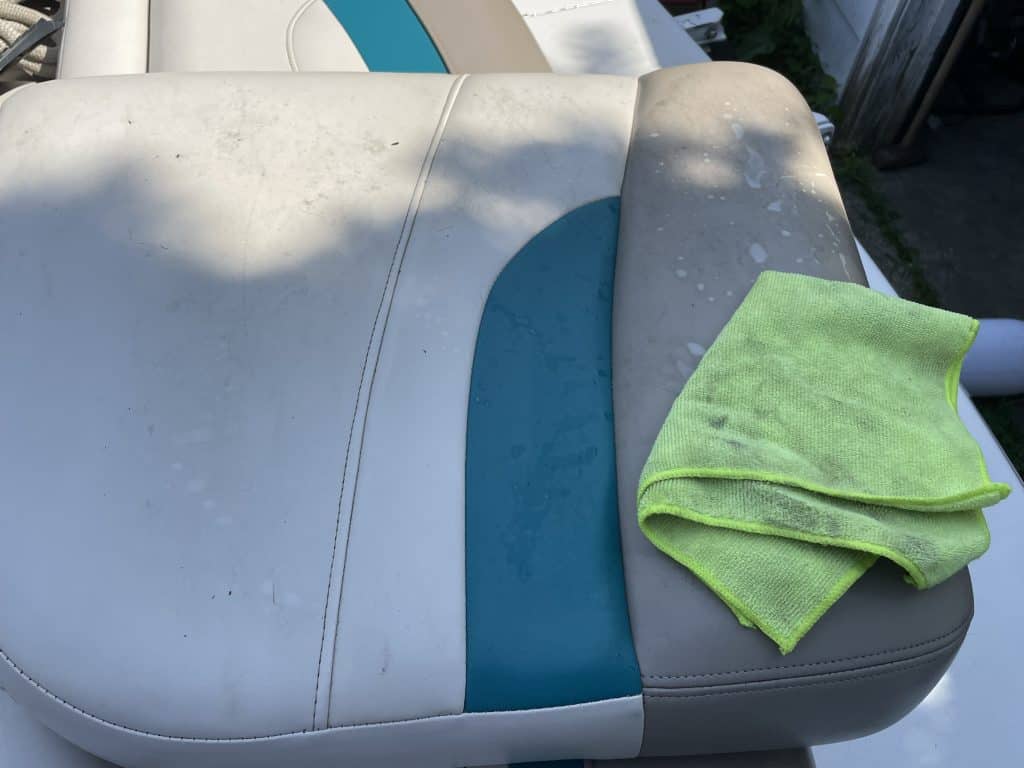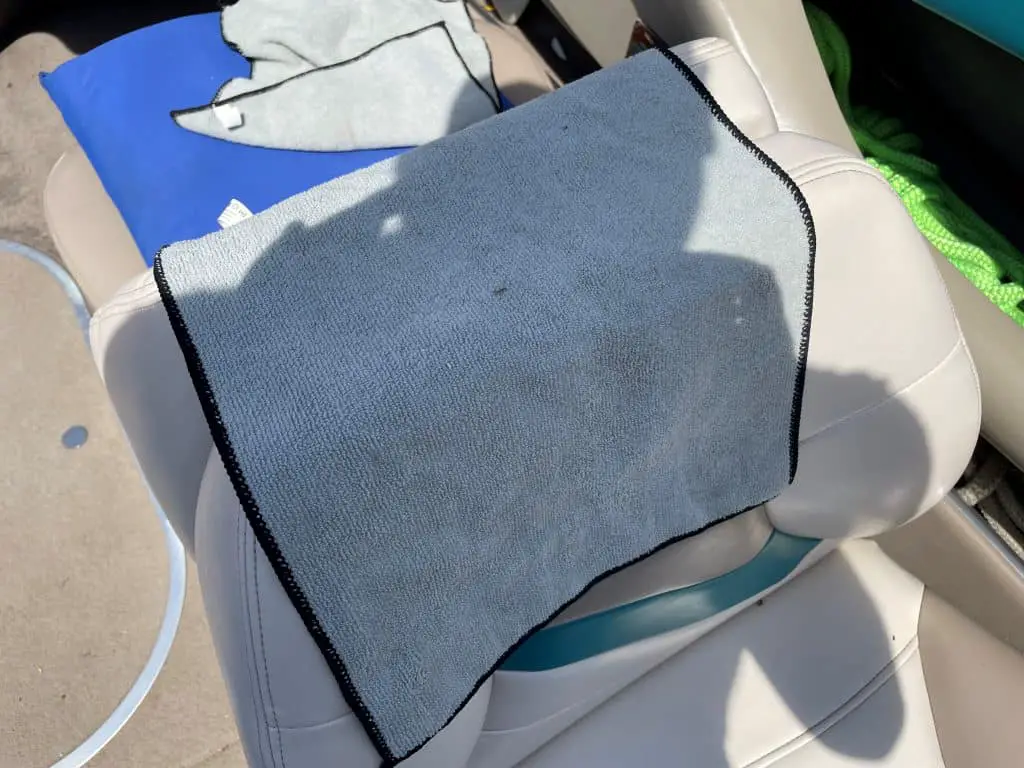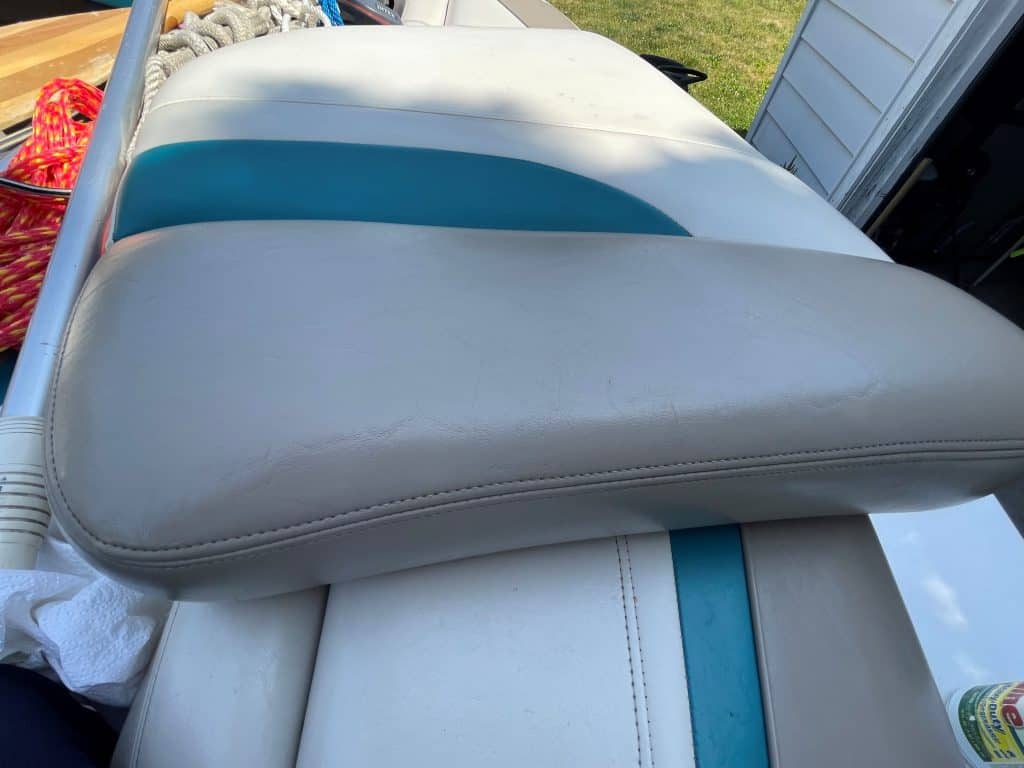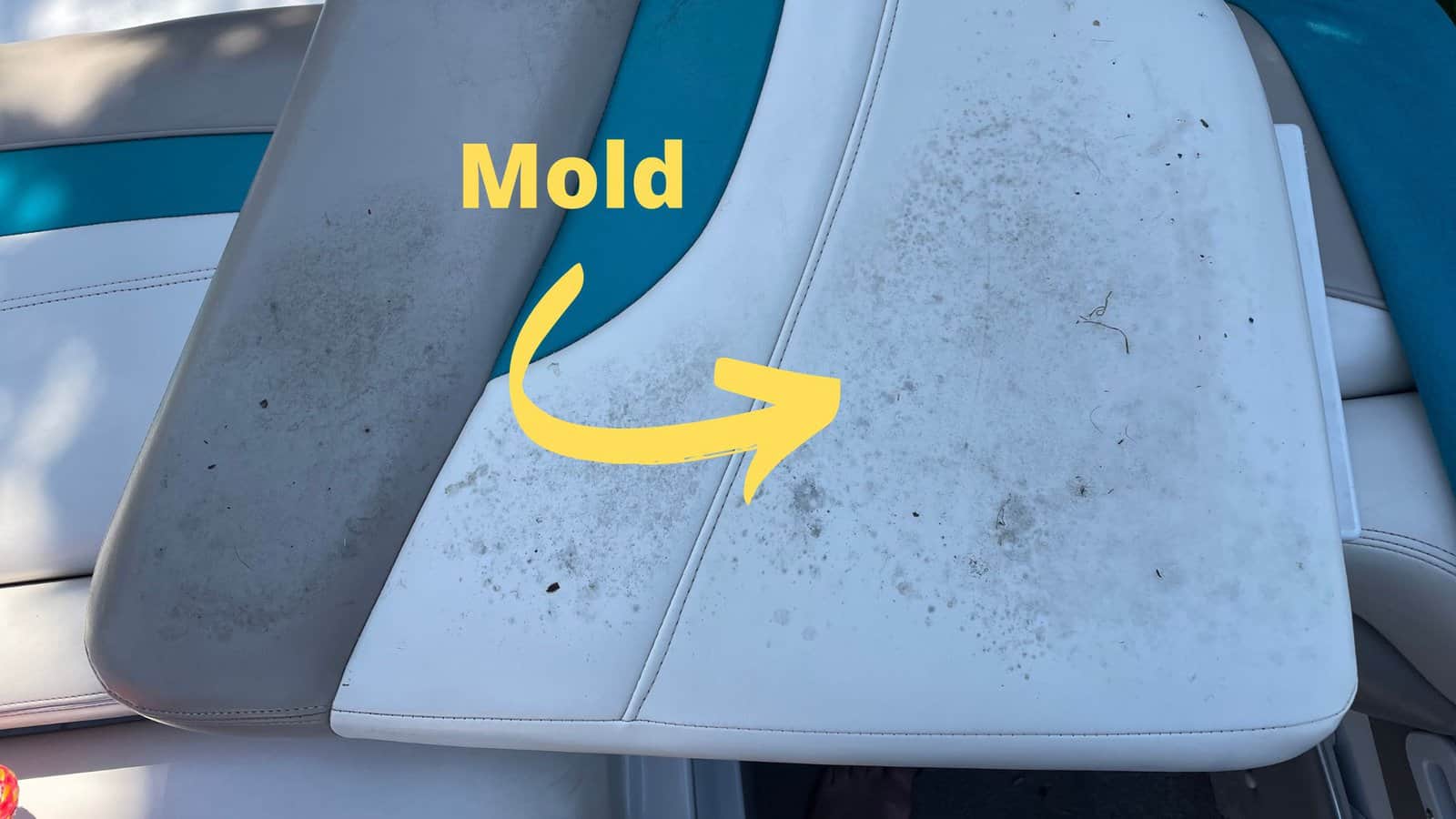When vinyl boat seats aren’t properly maintained and cleaned, mold and mildew can form on the surface of the seats. When left to develop, mildew can even spread to the inner foam. When you notice mildew on your vinyl seats, you need to deal with it immediately. However, many boat owners are unsure of how to do this!
To clean vinyl boat seats affected by mildew, a specialized cleaning solution can be used to clean mildew-stained seats. For milder stains caused by mildew, a homemade cleaning solution of baking soda and white vinegar can be used. Professional services can help with severe mildew infestations.
In this article, we’re going to explain everything you need to know about cleaning vinyl boat seats affected by mildew and mold. We’ll guide you through every step of the cleaning process, from which products to avoid to preventing mildew issues in the future!
Cleaning Vinyl Boat Seats Of Mildew
Whenever you take your boat out, your seats are bound to get wet. This is unavoidable! However, failure to adequately dry and care for your seats can lead to unwanted issues, such as mold and mildew developing. When it comes down to vinyl boat seats, mold and mildew can leave unsightly stains on your seats.
Mold and mildew can form on your vinyl seats whenever excess moisture is present. Of course, this excess moisture is the perfect breeding ground for mold and mildew. Once these stains have formed, many boat owners are unsure of what to do.
Many boat owners are quick to reach for bleach-based cleaners to deal with mold and mildew. However, this can be damaging to the vinyl material of your boat seats. Due to this, you should follow the correct procedure for cleaning your vinyl boat seats of mildew and mold.
Overall, there are three methods you can use to clean your boat seats. Firstly, you could use a specialized cleaning agent designed to clean mold and mildew. There are many such products available today which will effectively clean marine vinyl.
However, it’s also possible to use a safe homemade solution to clean vinyl boat seats. To do this, you’ll need to combine white vinegar and baking soda. This is a great (and cost-effective) way of dealing with light stains caused by mildew!
Now, you might be wondering about the third method. Well, that method entails calling a professional to help you clean your vinyl boat seats. In certain cases, mildew can spread into the foam of your vinyl seats. Ultimately, this is why it’s crucial to deal with mold and mildew as soon as you notice it.
However, if you fear your mildew issue is out of control, you can always call in a professional service to clean your seats. They will know exactly how to deal with your vinyl boat seats. This may entail cleaning or recovering your boat’s seats.
If you decide to clean your seats using a specialized or homemade cleaner, you can follow our simple steps to properly clean your vinyl boat seats. Not only will this ensure that you remove the mildew, but it will ensure that your seats are not damaged. Let’s get started!
10 Steps To Clean Vinyl Boat Seats Of Mildew

By following our cleaning steps, you’ll be able to remove any mildew from your vinyl boat seats. When cleaning the seats, you’ll be able to use a specialized mold removal product. However, you’ll also be able to the homemade cleaning solution.
The cleaning steps remain the same regardless of which cleaning solution you use. For stubborn mildew stains, a specialized cleaning agent would be recommended. When you’re just dealing with a few spots, our homemade solution will do the trick!
Step 1. Gathering Your Cleaning Supplies
The first step, of course, is gathering the necessary supplies to clean your vinyl boat seats. While you’ll be able to find some of these supplies in your cupboards, others can be ordered right to your doorstep! For each of these products, we’ve included the relevant link.
- Soft Brush
- Microfiber Cloth
- Magic Eraser Sponges
- Rubber Gloves
- Mold/Mildew Remover (Specialized Cleaning Solution) OR
- White Vinegar, Baking Soda, and Dishwashing Liquid (Homemade Cleaning Solution)
Step 2. Preparing Homemade Cleaning Solution
If you’ve purchased a specialized mold and mildew cleaning product, like the one linked above, you can proceed to Step Three. However, if you’ve decided to use a homemade solution instead, you’ll need to prepare this.
When preparing this solution, you need to combine 1 cup of white vinegar with one tablespoon of baking soda. This solution can be doubled using this ratio, depending on how much cleaning solution you’ll require for your boat’s vinyl seats.
Step 3. Apply Cleaning Solution To Vinyl Seats
Using Specialized Cleaning Solution
If you’re using a specialized mold and mildew removal product, you’ll need to refer to the instructions. This will indicate specific cleaning instructions. For the product we recommended, which is Star Brite’s Mold/Mildew Stain Remover and Cleaner, you can wipe or spray the cleaning solution.
Using Homemade Cleaning Solution
If you’re using our homemade cleaning solution, you can apply the solution by wiping or spraying it. When applying this solution, you’ll want to pay special attention to areas affected by mildew and mold. Once applied, you can proceed to the following step!
Step 4. Allow Cleaning Solution To Settle
Using Specialized Cleaning Solution
If you’re using a specialized cleaning solution, you’ll need to adhere to your product’s instructions. These instructions will indicate a recommended waiting period once you’ve applied the solution to your vinyl boat seats. Generally, this will be between 1 and 5 minutes.
Using Homemade Cleaning Solution
If you’re using a homemade cleaning solution, you’ll need to let your cleaning solution settle for a longer period. Generally, you’ll need to wait between 1 and 5 hours. However, for stubborn stains, you may need to let the cleaning solution settle overnight before proceeding.
Step 5. Gently Scrub Seats With Soft Brush
Using Specialized Cleaning Solution
Once you’ve waited the right amount of time, you can begin scrubbing your vinyl boat seats. To do this, you’ll need to use a soft brush recommended for upholstery cleaning. You should scrub gently to ensure that the seats are not damaged while you’re cleaning them.
Using Homemade Cleaning Solution
If you’re using the homemade solution, you would have left your solution to dry for longer. Due to this, you cannot start scrubbing immediately. First, you’ll need to apply some dishwashing liquid to your vinyl boat seats. Once you’ve done this, you can begin gently scrubbing the seats to remove mildew.
Step 6. Use Microfiber Cloth To Wipe Away Mildew

Once you’ve done some light scrubbing, you’ll want to wipe down your surface. To do this, you’ll need to use a microfiber cloth. Doing this will allow you to wipe away any mold and mildew from the vinyl material.
Step 7. Repeat Steps 3-6
Depending on the severity of your problem, you’ll need to repeat the cleaning steps a few times. While repeating these steps, you need to ensure that you focus on any hard-to-reach areas where mildew and mold could be hiding. This means scrubbing the seams of your vinyl seats, as well as the areas between them.
Step 8. Assess Your Cleaning Progress
Once you think you’ve done a thorough job scrubbing your vinyl boat seats, it’s time to assess your progress. If you’ve properly dealt with your mildew problem, you can proceed to Step Ten. However, if your mildew stains are more stubborn than you thought, you need to proceed to Step Nine.
Step 9. Use Magic Eraser Sponge For Stubborn Mildew Stains
For stubborn mildew stains, you’ll want to scrub the stains with a magic eraser sponge. You only need water to scrub stains with this versatile cleaning sponge. This sponge has proved highly effective in dealing with stubborn stains caused by mold and mildew. Once you’ve finished scrubbing your seats with the magic eraser, you can proceed to the final step!
Step 10. Finish Cleaning Your Vinyl Boat Seats

Using Specialized Cleaning Solution
Once again, you’ll need to refer to the provided instructions for what to do post-scrubbing when using a specialized cleaning solution. However, once you’ve finished cleaning your vinyl boat seats, you need to ensure that they’re fully dry. Along with our tips for keeping your seats mildew-free, this will ensure that you don’t have to repeat this cleaning process!
Using Homemade Cleaning Solution
If you use a homemade cleaning solution, you will need to rinse your boat seats with clean water. Of course, this is to remove any remaining vinegar and baking soda. Once you’ve done this, you can dry your vinyl seats with a microfiber cloth or towel. You’ll also want to consider applying a protective sealant, which we discuss below!
Tips To Keep Vinyl Boat Seats Free Of Mildew
Now that your vinyl boat seats are free of mildew, you’ll surely want to keep them that way! Luckily, the tips discussed below will help you do just that. Let’s look at how you can ensure that your boat’s vinyl seats remain free of mildew!
1. Use Protective Sealant On Vinyl Boat Seats
To help prevent mildew from forming on your vinyl boat seats, it’s advised that you purchase a protective sealant. These sealant products are applied to your seats to prevent both mold and mildew. When choosing a protective sealant, it’s crucial that you choose a product compatible with the material of your seats.
For vinyl seats, you’ll want to use a product like 303 Marine Aerospace Protectant. This fantastic product is a great way to protect your vinyl seats from mold and mildew. This product is also formulated to restore vinyl seats while protecting them against harsh UV rays. You can use this spray at often as needed!
2. Wipe Down Boat Seats After Rides
Boat seats get wet, it’s inevitable. When boat seats don’t look too wet, owners often allow their seats to air dry. By doing this, boat owners are risking mold and mildew from forming on their seats. Whether your seats are sopping or just lightly splashed, you need to dry them.
Whenever you’ve completed a ride, you should wipe down your vinyl seats. When wiping them down, you want to ensure that they’re completely dry. When moisture is left over on the surface of your seats, your seats become a breeding ground for mold and mildew.
3. Always Store Boats In Dry Areas
When you’ve returned from your boat ride, and you’ve properly dried your seats, you should store your boat in a dry area that’s well ventilated. Essentially, you want to ensure that your boat is properly sheltered from any harsh weather conditions. This includes rain, snow, and hail, which are common in maritime climates.
As discussed earlier, moisture facilitates mold and mildew. However, these weather conditions can damage more than just your vinyl boat seats! To protect your boat, you should always store it properly.
4. Clean Vinyl Boat Seats Regularly
Of course, one of the most important tips for keeping your vinyl boat seats free of mildew is to clean them regularly. One aspect of this is wiping your seats down when you come back from boat rides, as discussed earlier. You should also clean your boat seats during periods of inactivity. When you clean your vinyl boat seats, you can use the same products we discussed earlier.
The cleaning products you use are just as important as how often you use them! After all, the key here is cleaning vinyl seats regularly. By sticking to a cleaning routine, your vinyl seats will remain in stellar condition and mildew-free. Without any mildew to remove, cleaning your boat seats will be breezier than the ocean!
Conclusion
When moisture on vinyl boat seats is not properly dealt with, mold and mildew will form on the surface. When left to develop, mildew can even spread to the inner foam of a seat. Luckily, it is possible to clean vinyl seats affected by this.
This can be done by using a homemade solution or specialized cleaning agent. It’s also possible to prevent mildew and mold from forming by cleaning regularly and using a protective sealant for lasting protection.
Project “Ewww, Get That Mildew“ Boating
Check out our article on: Average Cost For A Pontoon Boat: (15 Examples)


